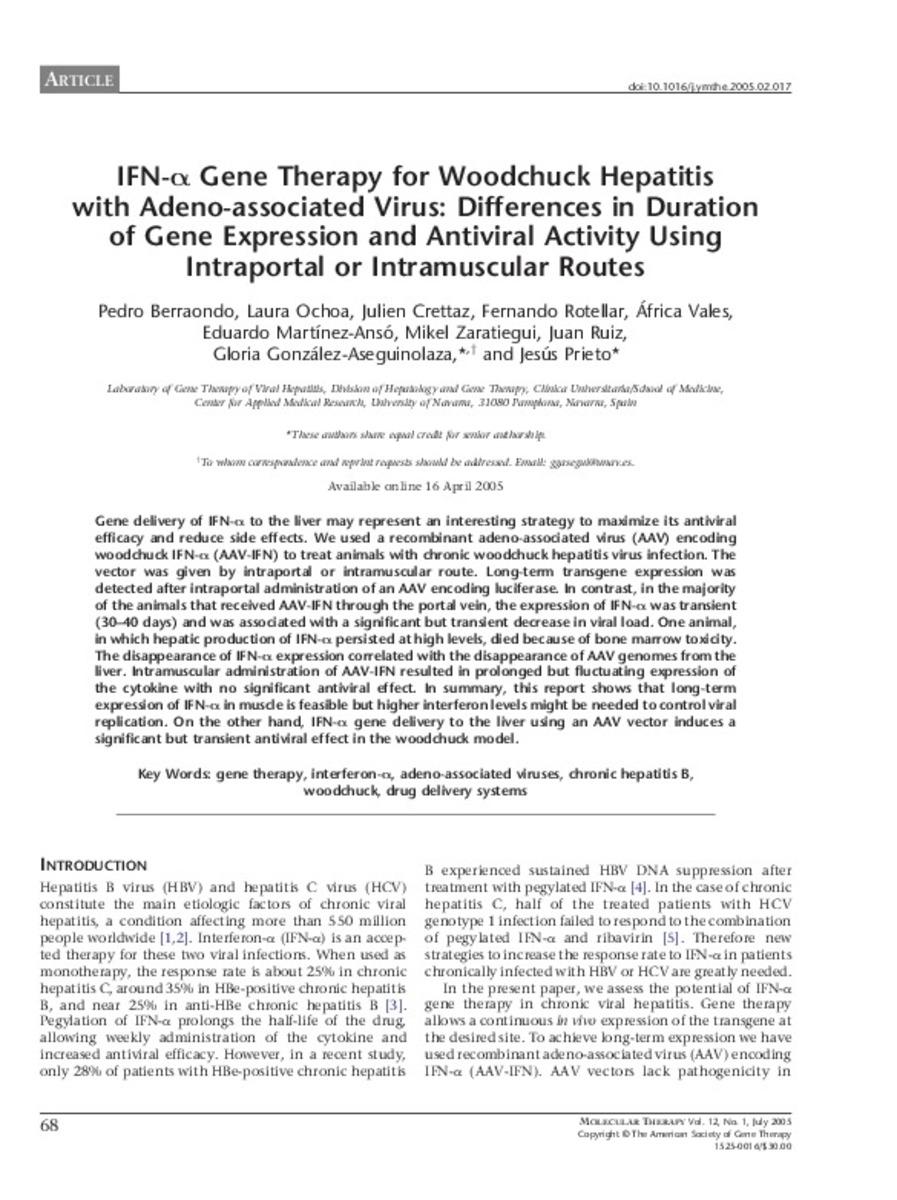Full metadata record
| DC Field | Value | Language |
|---|---|---|
| dc.creator | Berraondo, P. (Pedro) | - |
| dc.creator | Ochoa, L. (Laura) | - |
| dc.creator | Crettaz, J. (Julien) | - |
| dc.creator | Rotellar, F. (Fernando) | - |
| dc.creator | Vales, A. (África) | - |
| dc.creator | Martinez-Anso, E. (Eduardo) | - |
| dc.creator | Zaratiegui, M. (Mikel) | - |
| dc.creator | Ruiz, J. (Juan) | - |
| dc.creator | González-Aseguinolaza, G. (Gloria) | - |
| dc.creator | Prieto, J. (Jesús) | - |
| dc.date.accessioned | 2011-12-21T08:17:42Z | - |
| dc.date.available | 2011-12-21T08:17:42Z | - |
| dc.date.issued | 2005 | - |
| dc.identifier.citation | Berraondo P, Ochoa L, Crettaz J, Rotellar F, Vales A, Martinez-Anso E, et al. IFN-alpha gene therapy for woodchuck hepatitis with adeno-associated virus: differences in duration of gene expression and antiviral activity using intraportal or intramuscular routes. Mol Ther 2005 Jul;12(1):68-76. | es_ES |
| dc.identifier.issn | 1525-0016 | - |
| dc.identifier.uri | https://hdl.handle.net/10171/20332 | - |
| dc.description.abstract | Gene delivery of IFN-alpha to the liver may represent an interesting strategy to maximize its antiviral efficacy and reduce side effects. We used a recombinant adeno-associated virus (AAV) encoding woodchuck IFN-alpha (AAV-IFN) to treat animals with chronic woodchuck hepatitis virus infection. The vector was given by intraportal or intramuscular route. Long-term transgene expression was detected after intraportal administration of an AAV encoding luciferase. In contrast, in the majority of the animals that received AAV-IFN through the portal vein, the expression of IFN-alpha was transient (30-40 days) and was associated with a significant but transient decrease in viral load. One animal, in which hepatic production of IFN-alpha persisted at high levels, died because of bone marrow toxicity. The disappearance of IFN-alpha expression correlated with the disappearance of AAV genomes from the liver. Intramuscular administration of AAV-IFN resulted in prolonged but fluctuating expression of the cytokine with no significant antiviral effect. In summary, this report shows that long-term expression of IFN-alpha in muscle is feasible but higher interferon levels might be needed to control viral replication. On the other hand, IFN-alpha gene delivery to the liver using an AAV vector induces a significant but transient antiviral effect in the woodchuck model. | es_ES |
| dc.language.iso | eng | es_ES |
| dc.publisher | Nature Publishing Group | es_ES |
| dc.rights | info:eu-repo/semantics/openAccess | es_ES |
| dc.subject | Dependovirus | es_ES |
| dc.subject | Hepatitis B/therapy | es_ES |
| dc.subject | Interferon-alpha/genetics | es_ES |
| dc.subject | Marmota/virology | es_ES |
| dc.title | IFN-alpha gene therapy for woodchuck hepatitis with adeno-associated virus: differences in duration of gene expression and antiviral activity using intraportal or intramuscular routes | es_ES |
| dc.type | info:eu-repo/semantics/article | es_ES |
| dc.type.driver | info:eu-repo/semantics/article | es_ES |
| dc.identifier.doi | http://dx.doi.org/10.1016/j.ymthe.2005.02.017 | es_ES |
Files in This Item:
Statistics and impact
Items in Dadun are protected by copyright, with all rights reserved, unless otherwise indicated.






